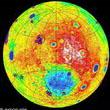A team of scientists working with NASA’s GRAIL mission has made a new high-resolution map of the Moon’s gravitational field that is more detailed than any yet produced, even for the Earth. The map records the signature of asteroid and comet impacts early in the Moon’s history, and shows that the crust of the young Moon took more of a pounding than scientists have previously thought. James W. Head, professor of geological sciences at Brown, was part of the team that generated and interpreted the new map. The findings are reported in three papers published in the journal Science. “We are now able to see in unprecedented detail how some of these large impacts have punched completely through the crust and dug into the lunar mantle,” he said. “This is helping us to understand the early history of our own planet and how such huge events may have inhibited the beginnings of life on Earth. We are also starting to see the details of early crustal structure that previously have been invisible due to the heavily cratered surface. This opens up a whole new window into the formative years of crustal formation on the Moon and other planets.” Maria Zuber, professor of geophysics at MIT and a Brown Ph.D., is the principal investigator on the GRAIL (Gravity Recovery and Interior Laboratory) mission. The mission involves twin probes, nicknamed Ebb and Flow, that track the Moon’s gravitational field from an altitude of approximately 34 miles.
Read more
